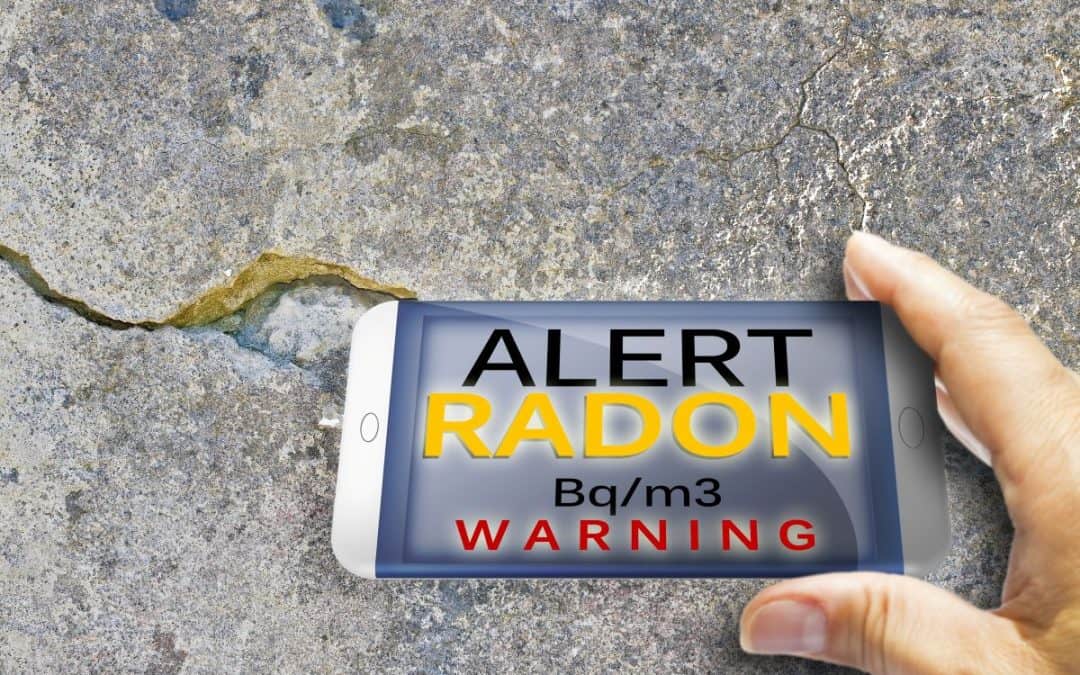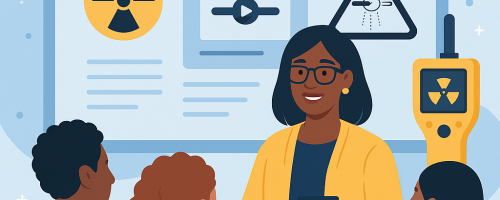You may have seen some local news articles in Canada early May 2025 about a recall of radon detectors. This is due to a consumer product recall and a consumer product advisory on certain models of radon detectors [1]. Some news articles also mention a health and safety risk from the recalled detectors. Radon is a radioactive gas that occurs naturally in our atmosphere. This blog post will help you better understand this recall and how to make better choices when picking a detector.
What is radon?
Radon is a radioactive gas that occurs naturally in our atmosphere. It is generated when other radioactive elements in the earth’s crust decay. When this decay happens, the solid elements turn into radon gas which can then diffuse through the soil and enter the atmosphere. Because houses typically have lower air pressure than the outside, they suck up gases in the soil and can lead to radon concentrating in houses. On average, radon concentrations outside are 5–15 Bq/m3 [2] and the average radon level of a Canadian residential building is 84.7 Bq/m3 [3]. Radon and the elements that it decays into are radioactive and emit ionizing radiation, which is carcinogenic to humans [4]. Because of this, Health Canada recommends mitigating indoor radon when the average radon levels in a building exceeds 200 Bq/m3 [5].
Wait, there’s radon everywhere?
Just as all humans are exposed to background radon levels (both outdoors and indoors), we also grew up and evolved with background ionizing radiation. We know a large amount of excess ionizing radiation is carcinogenic, but we do not fully understand the health effects of low levels of ionizing radiation. For the sake of radiation safety, scientists and professionals have assumed that low levels of ionizing radiation still produce a low level of increased risk to the development of cancer. This is called the linear no-threshold model [6]. Because of this model, it is often said that there is no safe amount of ionizing radiation or no safe amount of radon. Nevertheless, there is no way to reduce radon concentration to 0 Bq/m3 or to reduce background radiation to zero. If you are only exposed to background levels of ionizing radiation or radon, then your risks are the same as the rest of society.
Why was there a recall and advisory?
Some news articles cited a health and safety risk from the recalled devices. This is not because the device itself is introducing an extra risk, this is due to the devices not reporting radon levels accurately, potentially leading to consumers underestimating their exposure to radon gas. If the radon levels in your home are too high and you did not accurately measure and then mitigate it, then your excess exposure means that you have a higher chance of developing lung cancer compared to the average Canadian. The risk of using these devices rests entirely in its inaccuracy.
The big-picture answer to why is that there is no regulation on the sale of consumer grade radon detectors regarding their accuracy. Anyone can sell to Canadians by putting their product on Amazon (with exceptions for certain types of products like weapons, medical devices, pharmaceuticals, etc.). There is a program that certifies radon detectors in Canada for use by radon professionals [7], but many people are not aware of the certification program and do not look for it when shopping for radon detectors. Canada and Canadian scientists also do regular testing of these equipment for accuracy, which is how we realized these devices need to be recalled.
So, what is the solution?
A recent research paper co-authored by RSIC’s Brian Bjorndal [8] has observed the following regarding consumer-grade electronic radon monitors (“ERMs”): high-performance ERMs are typically produced by manufacturers with experience in radiation detection who also offer professional-grade ERMs approved by national accreditation bodies, low-performance ERMs typically do not have serial numbers, are primarily distributed through online marketplaces, and are produced by manufacturers with little to no history in radiation detection and who do not offer professional-grade ERMs. On average, low-performing ERMs are less costly than high-performing ones (approximately $80 CAD less out of the devices studied by the paper). Professional-grade devices are also regularly calibrated which is not a requirement (or even a possibility for some devices) for consumer-grade devices.
The accreditation body for professional-grade radon monitors as well as radon measurement and mitigation professionals is the Canadian National Radon Proficiency Program (“C-NRPP”). You can find a list of devices approved for radon professionals here: https://c-nrpp.ca/approved-radon-measurement-devices/. If you are hiring a measurement professional or a mitigation professional, it is also recommended to find a professional listed on the C-NRPP website here: https://c-nrpp.ca/find-a-professional/.
It is also useful to note that Health Canada has measurement protocols that any homeowner can use: https://www.canada.ca/en/health-canada/services/publications/health-risks-safety/guide-radon-measurements-residential-dwellings.html. They break down radon measurement devices into active (e.g., ERMs) and passive (e.g., alpha track or electret) devices. Passive devices are easier to use and cheaper to purchase, even including the lab fees for the analysis of your passive devices. Health Canada specifically recommends basing decisions on long-term measurements (3 months–1 year) during or including the heating season (October–April) [9]. Because of these guidelines, if you want to save money, pick a passive device and place it for 3+ months, if you can afford it, buy an active device and still wait for 3+ months to get the long-term result. In either case, if the long-term result is higher than 200 Bq/m3, then consider hiring a certified mitigation professional to mitigate your home.
References:
[1] The May 2025 product recalls and product advisory are found here:
- https://recalls-rappels.canada.ca/en/alert-recall/spolehli-radon-detector-recalled-due-inaccurate-radon-detection
- https://recalls-rappels.canada.ca/en/alert-recall/health-canada-warns-various-radon-gas-detectors-sold-amazonca-may-pose-health-and
- https://recalls-rappels.canada.ca/en/alert-recall/hanchen-home-radon-detector-recalled-due-inaccurate-radon-detection
- https://recalls-rappels.canada.ca/en/alert-recall/inkbird-wifi-radon-detector-model-rd-2-recalled-due-inaccurate-radon-detection
- https://recalls-rappels.canada.ca/en/alert-recall/various-life-basis-brand-radon-detectors-recalled-due-inaccurate-radon-detection
[2] This range is from the Canadian Cancer Society’s page on radon in the environment: https://cancer.ca/en/cancer-information/reduce-your-risk/know-your-environment/radon
[3] This average is from the Cross-Canada Survey of Radon 2024 published by the Evict Radon National Study team: https://crosscanadaradon.ca/survey/
[4] The International Agency for Research on Cancer classified radon and its decay products as carcinogenic to humans (Group 1) in 1988: https://publications.iarc.fr/Book-And-Report-Series/Iarc-Monographs-On-The-Identification-Of-Carcinogenic-Hazards-To-Humans/Man-Made-Mineral-Fibres-And-Radon-1988
[5] Health Canada has clear guidelines on how to measure for radon and when it is recommended to mitigate: https://www.canada.ca/en/health-canada/services/health-risks-safety/radiation/radon/reducing-levels-home.html
[6] The Linear No-Threshold Model is central to radiation protection industry and it is the reason why some people say “there is no safe dose of ionizing radiation”: https://www.cnsc-ccsn.gc.ca/eng/resources/health/linear-non-threshold-model/
[7] The Canadian National Radon Proficiency Program certifies radon measurement professionals, radon mitigation professionals, and professional-grade radon measurement devices: https://c-nrpp.ca/
[8] Article published in Health Physics on May 2, 2025: https://journals.lww.com/health-physics/fulltext/9900/performance_evaluation_of_electronic_radon.251.aspx
[9] Health Canada’s Guide for Radon Measurement in Homes: https://www.canada.ca/en/health-canada/services/publications/health-risks-safety/guide-radon-measurements-residential-dwellings.html







